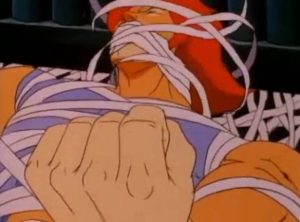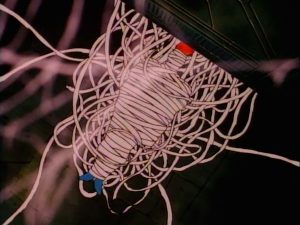Annotated 34-24
 I imagine that most of us who like cartoon entertainment (which I figure is most people who’ll read this) have some traumatic viewing experience that still gives them a chill to remember. Some will mention the shooting death of Bambi’s mom or the last moments of Optimus Prime in the 1986 animated movie. As a somewhat sheltered child, I had a bunch of scares that just embarrass me now, but the scenes here, of Thundercats hero Lion-O overpowered and entombed by the living bandages of his mummified enemy, can still induce a jittery tightness in my breath. (Did they really have to make it a cliffhanger, I was on tenterhooks for twenty-three-and-a-half hours after this, and I had to go to school and act like everything was fine because only losers got so messed up about cartoons and I had to prove I wasn’t… ahem.)
I imagine that most of us who like cartoon entertainment (which I figure is most people who’ll read this) have some traumatic viewing experience that still gives them a chill to remember. Some will mention the shooting death of Bambi’s mom or the last moments of Optimus Prime in the 1986 animated movie. As a somewhat sheltered child, I had a bunch of scares that just embarrass me now, but the scenes here, of Thundercats hero Lion-O overpowered and entombed by the living bandages of his mummified enemy, can still induce a jittery tightness in my breath. (Did they really have to make it a cliffhanger, I was on tenterhooks for twenty-three-and-a-half hours after this, and I had to go to school and act like everything was fine because only losers got so messed up about cartoons and I had to prove I wasn’t… ahem.)
 It’s part of my job to ask why such a reaction happens. What makes an effective slide from cartoon escapism into outright horror? It’s certainly somewhat subjective: if you weren’t as invested in my childhood diet of cartoons, or even if you were, you might look at these images and go “Well, that looks like a goofy trap someone thought up when they got bored taking their kids to the Egyptology exhibit” or “Furry BDSM, papa likey. Now spank him!”
It’s part of my job to ask why such a reaction happens. What makes an effective slide from cartoon escapism into outright horror? It’s certainly somewhat subjective: if you weren’t as invested in my childhood diet of cartoons, or even if you were, you might look at these images and go “Well, that looks like a goofy trap someone thought up when they got bored taking their kids to the Egyptology exhibit” or “Furry BDSM, papa likey. Now spank him!”
But when it works, I think it’s because the exaggerated nature of cartoons lends a certain starkness to moments that touch on the big themes they often deny: mortality, the cruelty of overwhelming force, and the indifference of the universe to your personal feeling of being your own life’s protagonist.











I can’t remember any childhood cartoon related trauma I may have experienced. Mostly because my dad’s extensive movie collection allowed me to sneak viewings of movies well outside my age range, and I ended up traumatizing myself watching Aliens(specifically the part when they start coming out of the walls). I immediately stopped the movie and noped right out of the living room. It was at least a decade before I ever bothered to finish that film.
(I love the series now, but 8 year old me was not prepared.)
It didn’t TRAUMATIZE me, but there were definitely moments in Brave Little Toaster that I watched as a kid and thought “Damn, that’s fucked up”
Another not-actually-related-to-the-current-comic Thing, but – assuming I haven’t been majorly misunderstanding things – y’all may want to update the “Written By” section of the site header
As I understand, that’s part of the actual image file and beyond T’s technical capabilities to correct for these retrospectives
This is definitely right at the limits of my technical capabilities, but I think I’ve set it up so it’ll be corrected with the next update. I sure don’t envy Samantha and Flo’s dealings with the site’s back end!
Also the ‘Creators’ page.
Done, though that whole section remains pretty dated in terms of what we’re up to now.
Two words: Purple Smurfs.
Gnap gnap!
Why would you dig out that repressed memory!?
I’m remembering this in French!
I felt I had to leave the room at the “Hey, who turned out the lights?” bit of those episodes of Doctor Who in the library, and really quite a few Doctor Who moments. As for cartoons I can’t really think of much. Maybe some of the stuff in Princess Mononoke or Howl’s Moving Castle but I don’t think it left as much of a mark.
When I watched Doctor Who (didn’t stop for any reason other then I ran out of episodes at the time and haven’t gotten around to continuing) I had to give myself a rule not to watch it after dark because of stuff like the Vashta Nerada and weeping angels
I think the word ‘traumatized’ is used way to often on the internet, especially in regards to Saturday morning cartoons of old.
It should probably be understood (and intended) as a cheeky exaggeration. No scare I received from cartoons should be confused with actual PTSD.
Now that you mention it, there is a Thundercats episode that freaked me out back when it aired. Mongor the demon, featured in the epsiode “Mongor”, really struck a nerve, due to of my early fear of satanic imagery. I mean, an undead corpse chanting incantations in his tomb before four grotesque evil pagan idols is certainly evil worship, but to me, that scene was too Conan The Barbarian to be taken too seriously (also, Mumm-Ra’s ripped look was more “kewl” than scary). But this other guy was Baphomet! The Thundercats were fighting Baphomet! Mongor wasn’t like, say, Stampede from Bravestarr, who was menacing and demon-like, yes, but too sci-fi and cartoony to be really disturbing. It was weird for me that Mongor was only a non-returning villain, instead of the biggest threat the Thundercats even faced
I have a lot of disturbing memories from watching 70’s and 80’s anime as well, but then again, anime is an entirely different kind of beast, so let’s leave it at that for now
Most of the cartoon stuff I saw incited a “whoa!!! cool!!! bizarre!!!” reaction from me, but I will say that if I had to name a traumatizing cartoon experience it would be the There’s No Place Like Springfield from the 80’s G.I. Joe series. I don’t know if it was part one or two but when people start melting in front of you, you get more of a “whoa… cool?” …bizarre” vibe.
Jonny Quest, “The Invisible Monster”.
The Original Jonny Quest, not that “new adventures” crap from the 90’s. Scariest episode of the series, with the possible exception of the “Curse of Anubis” episode being a close second.
Watership Down. Especially the Brown Bunny Swirl of Death.
The only thing that comes to mind of things that overly bothered me as a child was a scene from the end of Superman III where the female antagonist-adjacent whose name I have no chance of remembering is forcibly taken and transformed into a robot or cyborg. Something about the way it was done bothered my childhood self, and it was the only Superman movie I remember being on network TV more than once in a great while.
Also, meant to have this in the main post, but I have an 8-year-old yammering about Zelda to me. I think cartoons and cartoonish things can elicit those sorts of reactions sometimes because they be so out of place. In Willy Wonka there’s the scene with crawling insects and a chicken being beheaded while Gene Wilder affects a manic expression with his voice rising to a shout throughout shortly after a colorful and whimsical scene.
Other times it might be the way that cartoon characters, so overly larger-than-life and eternally triumphant, reflect they way our parents felt when we were children. If Optimus Prime, super Good Guy robot, can DIE…
WHY DID YOU REMIND ME OF THAT SCENE?
I wasn’t able to sleep for several nights after seeing that scene, and I’m pretty sure it gave me a lifelong phobia.
101 Dalmatians. When Cruella de Ville drove her car over that ridge, her angry face filling the screen, I about wet myself.
I’m with John. That paint-coated blob was just terrifying.
Also, “RETURN THE SLAB.”, but in a good way.